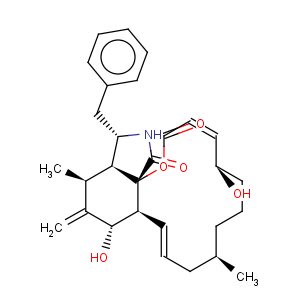Title: Cytochalasins
Literature References: A class of mold metabolites exhibiting a number of unusual and varied effects on animal cells. More than twenty cytochalasins are known, isolated from several different mold spp. All are characterized by a highly substituted hydrogenated isoindole ring of known configuration to which is fused a macrocyclic ring. This ring may vary from 11 to 14 atoms in size and may be either a carbocycle or a lactone. Isoln and structure of cytochalasins A, B, C, D: Aldridge
et al., J. Chem. Soc. C 1967, 1667;
eidem, Chem. Commun. 1967, 26; of E and F: Aldridge
et al., ibid. 1972, 148. Revised structures of cytochalasins E and F: Aldridge
et al., ibid. 1973, 551; Büchi
et al., J. Am. Chem. Soc. 95, 5423 (1973). Isoln of H, also known as
paspaline-P or
kodocytochalasin-1: G. S. Pendse,
Experientia 30, 107 (1974). Structure of H: S. A Patwardhan
et al., Phytochemistry 13, 1985 (1974); M. A. Beno
et al., J. Am. Chem. Soc. 99, 4123 (1977); x-ray crystal and molecular structure: J. A. McMillan
et al., Chem. Commun. 1977, 105. Isoln of K, L, M from
Chalara microspora and proposed structures: T. Fex,
Tetrahedron Lett. 22, 2703 (1981). Isoln of E and K from
Aspergillus clavatus and proposed alternate structure of K: P. S. Steyn
et al., J. Chem. Soc. Perkin Trans. 1 1982, 541. Partial synthesis of A and B: S. Masamune
et al., J. Am. Chem. Soc. 99, 6756 (1977). Total synthesis of B: G. Stork
et al., ibid. 100, 7775 (1978). Major biological effects are the blockage of cytoplasmic cleavage by blocking formation of contractile microfilament structures, resulting in multinucleate cell formation, the reversible inhibition of cell movement, and the induction of nuclear extrusion: Carter,
Nature 213, 261 (1967); Krishan,
J. Cell Biol. 54, 657 (1972); E. D. Korn,
Physiol. Rev. 62, 703 (1982). Correlation between effects of cytochalasins on cellular structures and cellular events and those on actin
in vitro: I. Yahara
et al., J. Cell Biol. 92, 69 (1982). Other reported effects include the inhibition of glucose transport, of thyroid secretion, of growth hormone release, of phagocytosis, and of platelet aggregation and clot contraction.
See D. A. Hume
et al., Nature 272, 359 (1978). Nomenclature: M. Binder
et al., J. Chem. Soc. Perkin Trans. 1 1973, 1146.
Reviews: M. Binder, C. Tamm,
Angew. Chem. Int. Ed. 12, 370 (1973); R. B. Herbert in
The Alkaloids vol. 7, J. E. Saxton, Ed. (The Chemical Society, London, 1977) pp 29-30; W. G. Thilly
et al., Front. Biol. 46, 53-64 (1978); L. V. Domnina
et al., Proc. Natl. Acad. Sci. USA 79, 7754-7757 (1982); W. Siess
et al., ibid. 7709-7713.
Derivative Type: Cytochalasin B
CAS Registry Number: 14930-96-2
CAS Name: (7
S,13
E,16
R,20
R,21
E)-7,20-Dihydroxy-16-methyl-10-phenyl-24-oxo[14]cytochalasa-6(12),13,21-triene-1,23-dione
Synonyms: (
E,E)-16-benzyl-6,7,8,9,10,12a,13,14,15,15a,16,17-dodecahydro-5,13-dihydroxy-9,15-dimethyl-14-methylene-2
H-oxacyclotetradec[2,3-
d]isoindole-2,18(5
H)-dione; phomin
Molecular Formula: C29H37NO5
Molecular Weight: 479.61
Percent Composition: C 72.62%, H 7.78%, N 2.92%, O 16.68%
Literature References: The most important and biologically studied of the cytochalasins. Formerly isolated from cultures of a
Phoma sp. and called phomin: Rothweiler, Tamm,
Experientia 22, 750 (1966). Physicochemical data: A. E. Pohland
et al., Pure Appl. Chem. 54, 2219 (1982).
Properties: Felted needles from acetone, mp 218-221°. Completely stable under normal conditions. Solutions in DMSO show no decrease in potency when stored at 4° for three years (Aldrich data sheet). Solubility (mg/ml at 24°): acetone 10.3; ethanol 35.4; DMSO 371; DMF 492. Insol in water.
Melting point: mp 218-221°
Use: As tools in cytological research and in characterization of polymerization properties of actin,
q.v.

